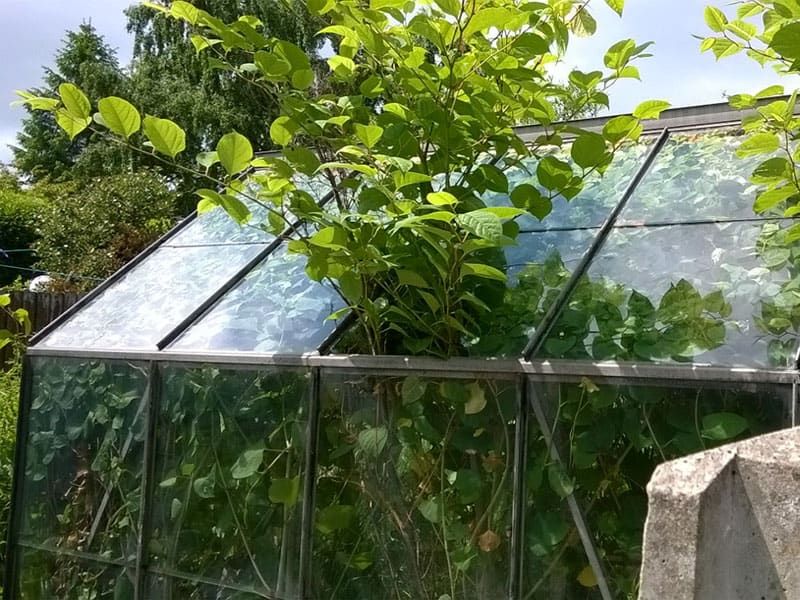
We all know that Japanese knotweed is a problem with the ability to grow through concrete, cause faults in pipes, and force its way through brickwork. It's therefore no surprise that homeowners find the situation deeply concerning when knotweed is discovered on or close to their land, as this can reduce property value considerably.
Derbyshire Japanese knotweed infestation case study
A Derbyshire homeowner contacted the TCM team for some expert advice and help in addressing the invasive situation when they realised that Japanese Knotweed was growing through the roof of a neighbours greenhouse at a frighteningly rapid rate.
Unwittingly introduced by the Victorians
Brought to the UK by the Victorians and considered at the time an 'exotic delight', little did they realise what devastation it would cause with nothing to curb its appetite. In its native habit other plants and insects would keep the plant at bay, however, these species are not present in the UK, hence the invasive behaviour of the plant. From uprooting our native species, to taking over peoples' homes, this once sought-after plant has proven to be anything but a 'delight'! The truth is, Japanese knotweed can cost you money, space and your health. Plus, as with the above case, it can cause upset between neighbours!
If you have Japanese growing in your garden, here's what to know:
How to recognise Japanese knotweed
As with many plants, Japanese knotweed appearance changes with the seasons. Some months the plant may not even be visible above ground, but the rhizome (root of the plant) is alive and well underground, biding it's time, waiting for spring to arrive and to begin its life of devastation.
Spotting Japanese knotweed!
For a comprehensive Japanese knotweed spotting guide visit our identification page. Otherwise, send us your pictures via our contact page and our experts will be able to confirm if you have the invasive species growing on your property.

So you have Japanese knotweed, now what?
Once you have positively identified the plant, you need to take immediate action. Although not a poisonous plant, it is illegal to allow it to spread onto a neighbouring property or land, and not only can you face legal action but it will reduce the value of your property, and cause extensive damage if left to take over a building or land plot.
Our Derbyshire homeowner contacted us about her neighbour's greenhouse, as far from growing tomatoes and green beans, the invasive plant was reaching its full 3m potential and encroaching on her land. Here's what we suggested to do next:

How to remove Japanese knotweed - treatment options
For one, you shouldn't ignore this voracious plant, nor should you try to eradicate it yourself. Instead, we recommend you take a photo diary of the plants growth, location of the plant, etc., as we have mentioned in previous posts, and always ask an expert for best steps forward.
Spray and injection method
Our herbicide treatments are liquid poison to Japanese knotweed. We apply it either by spraying the plant, or injecting the solution into the stem. This treatment method needs to be applied over a number months or years to work effectively.
Dig and dump method
As the name suggests, our experts dig up the plant and root and dump it on a licensed Japanese knotweed landfill site. This method is quicker than using sprays and injections, but only if our experts have easy access to the plant. We remove every last root, stem and seed to totally eradicate the problem.
We provide a range of Japanese knotweed removal services for both residential and commercial customers. Get in touch to find out more, discuss treatment options and to schedule a site survey.

Your neighbours aren't compliant - what now?
This invasive species doesn't care about boundaries. It doesn't care whether the land belongs to you, or your neighbour. Usually, all parties infected seek expert advice from a professional knotweed removal company to put a stop to the spreading, and consequential damage.
Sadly, not all neighbours are willing to help. For our Derbyshire-based client and others who come up against the same problem, we suggest the following:
- Hire a Japanese knotweed expert to remove the plant from your property;
- Add a barrier membrane to the property line to stop the plant re-encroaching from the neighbour's garden. A professional removal service will be able to take care of this with ease and efficiency;
- Contact a solicitor to get the legal action ball rolling;
- If based in England or Wales, ask your local council for a 'community protection notice'. This is obtained by proving the neighbours were informed of the infestation and have taken no reasonable action to remove it. The community protection notice will force the neighbouring party to take action.
The law is on your side
If your neighbour is doing nothing to remove Japanese knotweed, remember that the law is on your side. According to Gov.uk, an individual can be fined up to £5000 or sent to prison for two years for failing to address the spread of knotweed to another party's land - not only is the law on your side, so are we!
Don't delay in getting in touch with Dr Knotweed and co, we are here to help alleviate the problem in the short term and eradicate it completely for the long term!